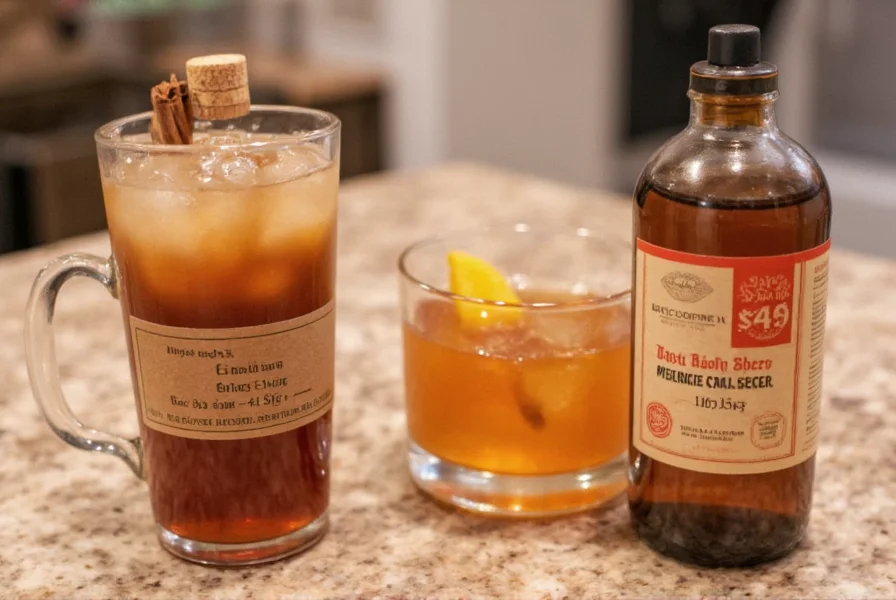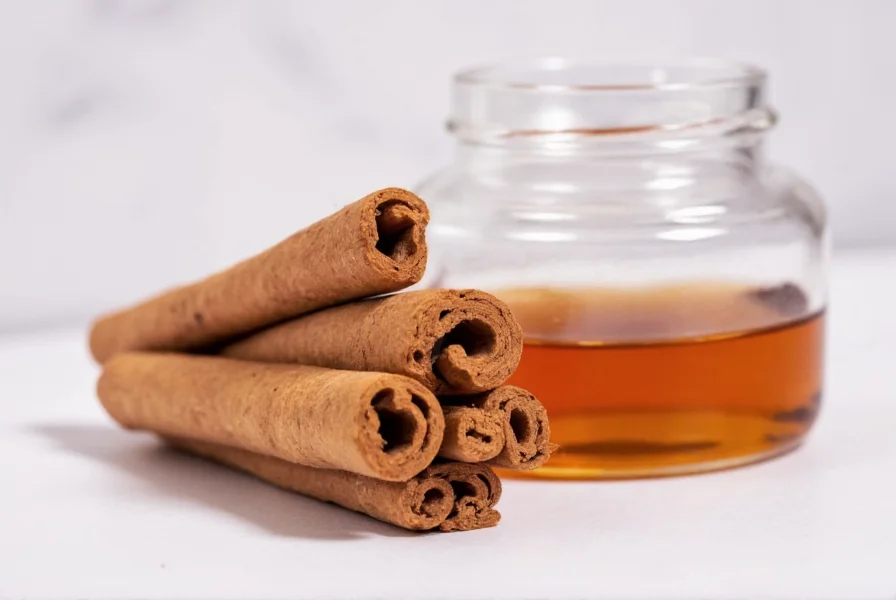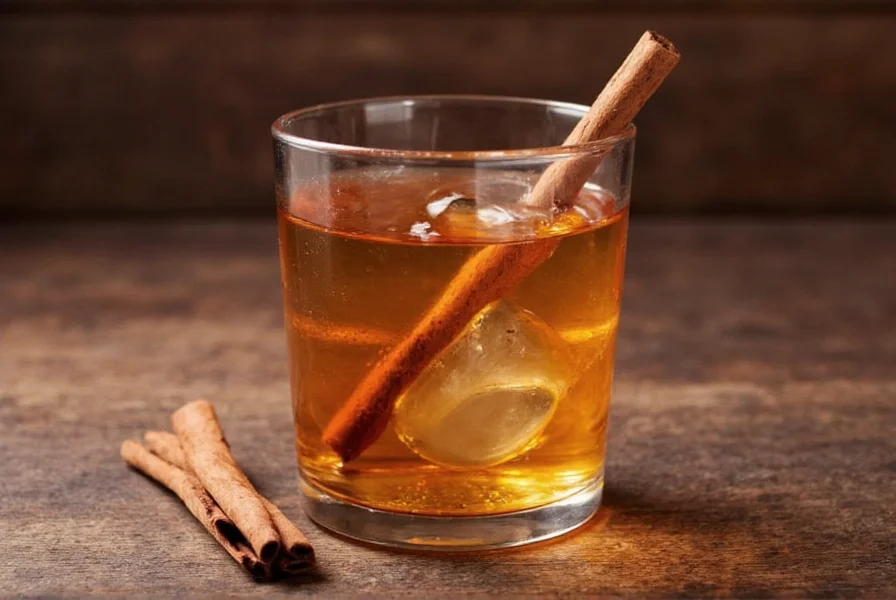Cocktail enthusiasts and professional mixologists value cinnamon bitters for their ability to add depth and complexity to drinks. Unlike simple cinnamon syrup, which adds sweetness, bitters provide intense flavor with minimal volume, making them indispensable in craft cocktail creation. The alcohol base preserves the botanical extracts while helping to bind flavors in mixed drinks.
What Exactly Are Cinnamon Bitters?
Cinnamon bitters belong to the broader category of aromatic bitters—high-proof alcohol solutions infused with botanical ingredients. The primary component is cinnamon bark (usually Ceylon or Cassia varieties), often combined with supporting botanicals that complement cinnamon's warm, sweet-spicy character.
Commercial cinnamon bitters typically contain:
- 35-45% alcohol (serving as both preservative and extraction medium)
- Cinnamon bark (the dominant flavor)
- Supporting spices (cloves, allspice, nutmeg)
- Citrus elements (orange or lemon peel)
- Bittering agents (gentian root, quassia)
- Subtle sweeteners (in some formulations)
| Bitter Type | Primary Flavor Notes | Best Cocktail Applications | Alcohol Content |
|---|---|---|---|
| Cinnamon Bitters | Warm spice, sweet wood, subtle heat | Old Fashioneds, whiskey cocktails, autumn drinks | 35-45% |
| Aromatic Bitters | Herbal, gentian, subtle spice | Cocktails requiring complexity without dominant spice | 40-47% |
| Orange Bitters | Citrus peel, floral notes | Manhattans, Martinis, clear cocktails | 38-45% |
| Chocolate Bitters | Roasted cocoa, vanilla | Rum cocktails, dessert drinks | 35-42% |
Historical Context of Cinnamon in Mixology
Cinnamon's journey into cocktail culture dates back to the early days of mixed drinks in the 19th century. Originally used in medicinal tonics, cinnamon's warming properties made it a natural transition to social beverages. The first commercial bitters emerged around 1806, with cinnamon featuring prominently in early formulations like Peychaud's Bitters.
During Prohibition, cinnamon bitters gained popularity as mixologists sought to mask the harsh flavors of poorly distilled spirits. The spice's robust character effectively covered undesirable notes while adding welcome complexity. Today, the craft cocktail renaissance has revived interest in specialized bitters, with cinnamon varieties experiencing particular growth among home and professional bartenders.
Flavor Profile and Sensory Characteristics
Cinnamon bitters deliver a multi-dimensional flavor experience that evolves as a cocktail is consumed. The initial impression features bright top notes of citrus peel, followed by the signature warmth of cinnamon, and finishing with subtle bitter undertones from supporting botanicals.
Quality cinnamon bitters should exhibit:
- A balanced spice profile without overwhelming heat
- Distinct cinnamon character without artificial candy-like notes
- Supporting botanicals that enhance rather than compete
- A clean finish that doesn't linger unpleasantly
- Integration that enhances rather than dominates the cocktail
When evaluating cinnamon bitters, professional mixologists often look for what's called "flavor carry"—the ability of the bitters to maintain their character throughout the drinking experience rather than dissipating quickly.
Practical Applications in Cocktail Crafting
Cinnamon bitters shine in spirit-forward cocktails where their warming spice complements rather than competes with base spirits. The most successful applications include:
Whiskey and Bourbon Cocktails
The natural affinity between cinnamon and whiskey makes these bitters ideal for Old Fashioneds, Manhattans, and Boulevardiers. Just 2-3 dashes can transform a standard recipe into a seasonally appropriate variation with added complexity.
Winter and Autumn Specialty Drinks
Cocktails featuring apple brandy, rum, or aged tequila benefit from cinnamon bitters' warming qualities. They're particularly effective in drinks that already contain complementary ingredients like apple cider, maple syrup, or pumpkin.
Unexpected Pairings
Innovative bartenders have discovered surprising applications for cinnamon bitters in drinks you might not expect:
- Gin cocktails: Adds warmth to floral gins in autumn/winter
- Tequila drinks: Complements reposado and añejo tequilas
- Clear cocktails: Provides depth without coloring the drink

Selecting Quality Cinnamon Bitters
With the craft bitters market expanding rapidly, choosing quality products requires attention to several factors:
Ingredient Transparency
Reputable producers clearly list all ingredients. Be wary of products that simply state "natural flavors" without specificity. The best cinnamon bitters will identify the cinnamon variety (Ceylon being preferred for its more delicate flavor) and key supporting botanicals.
Balanced Formulation
Sample the bitters before incorporating them into your cocktail program. Quality cinnamon bitters should taste complex but balanced when diluted—try adding a few dashes to sparkling water. The cinnamon should be present but not overwhelming, with supporting notes emerging as the flavor develops.
Production Methods
Traditional maceration (steeping botanicals in alcohol for weeks or months) generally produces more nuanced results than quick infusion methods. Some premium producers use multiple infusion stages to extract different flavor components from the same botanical at optimal times.
Creating Homemade Cinnamon Bitters
Making your own cinnamon bitters allows for complete customization of flavor profile. This basic recipe yields approximately 8 ounces of finished product:
Basic Homemade Cinnamon Bitters Recipe
- 8 oz high-proof neutral spirit (100-proof vodka or grain alcohol)
- 15g Ceylon cinnamon sticks, broken into small pieces
- 3g whole cloves
- 2g allspice berries
- 1 organic orange peel strip (1" x 3")
- 0.5g gentian root (for bittering)
- Optional: 5mL pure vanilla extract (added after straining)
Preparation Method
- Combine all ingredients except vanilla in a clean glass jar
- Seal tightly and store in a cool, dark place
- Shake gently once daily for 14-21 days
- Strain through a coffee filter into clean bottle
- Add vanilla extract if using and cap tightly
- Allow to mellow for 1 week before use
This homemade cinnamon bitters recipe creates a versatile product suitable for most cocktail applications. For a more intense cinnamon flavor, increase the cinnamon to 20g. For a spicier profile, add a small piece of dried chili. The alcohol content ensures a virtually indefinite shelf life when stored properly.

Signature Cocktail Featuring Cinnamon Bitters
The Spiced Maple Old Fashioned showcases cinnamon bitters' ability to transform a classic cocktail:
- 2 oz bourbon or rye whiskey
- 1/4 oz pure maple syrup
- 3 dashes cinnamon bitters
- Lemon twist for garnish
Combine all ingredients in a mixing glass with ice. Stir for 25-30 seconds until well-chilled. Strain into a rocks glass over a large ice cube. Express lemon oils over the drink and drop the twist in as garnish. The cinnamon bitters integrate seamlessly with the maple and whiskey, creating a harmonious flavor profile greater than the sum of its parts.
Storage and Shelf Life Considerations
Proper storage ensures your cinnamon bitters maintain optimal flavor. Store bottles in a cool, dark place away from temperature fluctuations. While the high alcohol content prevents spoilage, light and heat can degrade flavor compounds over time.
Commercial cinnamon bitters typically remain at peak quality for 1-2 years after opening. Homemade versions may have a slightly shorter optimal window of 6-12 months. Always use clean droppers or dashes to prevent contamination. If your bitters develop off odors, significant color changes, or sediment, it's time to replace them.
Conclusion
Cinnamon bitters represent one of the most versatile specialty bitters for cocktail enthusiasts. Their warm, complex profile enhances rather than dominates, making them valuable for both classic cocktail variations and innovative creations. Whether purchasing commercial varieties or crafting your own, understanding the nuances of cinnamon bitters unlocks new dimensions in cocktail crafting that can transform ordinary drinks into extraordinary experiences. As the craft cocktail movement continues evolving, cinnamon bitters remain a staple ingredient that bridges traditional techniques with contemporary creativity.
Frequently Asked Questions
What's the difference between cinnamon extract and cinnamon bitters?
Cinnamon extract is typically a concentrated flavoring made by steeping cinnamon in alcohol, designed primarily for baking with minimal bitter components. Cinnamon bitters contain additional bittering agents like gentian root along with supporting botanicals, creating a more complex flavor profile specifically formulated for cocktail use. Bitters are more concentrated and contain intentional bitter elements that help balance sweetness in drinks.
How many dashes of cinnamon bitters should I use in a cocktail?
The standard measurement is 2-3 dashes for most cocktails, though this varies by recipe and personal preference. Start with 2 dashes in spirit-forward drinks like Old Fashioneds, and adjust to taste. Remember that dashes are not precise measurements—actual volume depends on the dropper and how vigorously you shake the bottle. For precise replication, consider using a milliliter measuring tool once you've determined your preferred amount.
Can I substitute regular bitters for cinnamon bitters in recipes?
You can substitute aromatic bitters like Angostura in a pinch, but the flavor profile will differ significantly. Regular aromatic bitters lack the prominent cinnamon notes and will produce a more herbal, less spicy result. For closer approximation, combine 2 dashes of aromatic bitters with 1 dash of orange bitters. True cinnamon bitters provide a distinctive warmth that's difficult to replicate with standard bitters alone.
Do cinnamon bitters contain sugar?
Most traditional cinnamon bitters contain little to no sugar, relying on the natural sweetness of cinnamon rather than added sweeteners. Some modern craft formulations may include minimal sweetening agents, but they remain predominantly bitter rather than sweet. Always check the ingredient list if sugar content is a concern, as this varies by brand. The perception of sweetness comes from cinnamon's natural compounds rather than actual sugar content.
Are there non-alcoholic alternatives to cinnamon bitters?
Non-alcoholic alternatives exist but function differently than traditional bitters. Some companies produce glycerin-based or vinegar-based bitter alternatives, though these lack the alcohol's flavor-binding properties. For mocktails, try creating a concentrated cinnamon syrup with additional bitter elements like gentian tea. Note that non-alcoholic versions won't integrate into drinks in the same way as alcohol-based bitters and may separate or settle differently.











 浙公网安备
33010002000092号
浙公网安备
33010002000092号 浙B2-20120091-4
浙B2-20120091-4